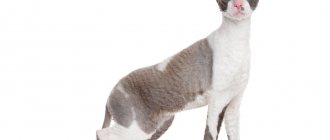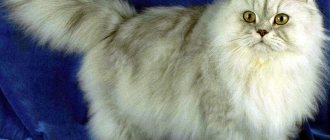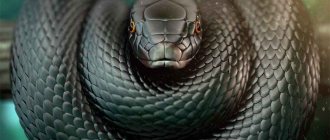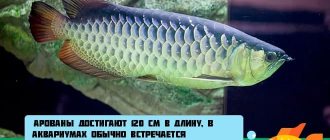Post Views: 660
5
(6)
There are not many species of fish with bright colors found in their natural habitat. In nature, most inhabitants blend with their environment. Some do this to reliably hide from predators, while others do it to ambush prey. For the wide variety of bright and beautiful aquarium fish, we must thank generations of breeders who have been working for decades and strive to preserve the most spectacular representatives of various species. Aquarists today have the opportunity to fully enjoy the results of this work. We would like to bring to your attention the 10 most beautiful aquarium fish.
Discus
Discus fish are one of the most beautiful aquarium fish. Their body size reaches 25-30 cm; the body is disc-shaped and strongly compressed from the sides. The colors of discus fish are varied and depend on the morph; they are dominated by blue, blue, red, orange and yellow shades. Discus fish are delicate fish that are susceptible to stress and disease. They cannot tolerate fluctuations in water parameters and excess nitrogen compounds. The water should be warm (27-30°C), acidic (pH 5.5-6.5) and soft (dH 1-12°). Good filtration and aeration are important.
Aquarium pets are not for beginners
Very often, people, carried away by the appearance of a particular fish, immediately drag it into their aquarium, and then are also indignant that it has not taken root. This is fundamentally wrong.
Names of the most unsuccessful fish species for the first experiment:
- roosters. They can be found in any market, they are very colorful and very beautiful, they can have an iridescent red or blue tail. In addition, they eat almost anything they can get their hands on, but it’s not for nothing that this fish was named that way. Roosters are very conflicting fish, one of the most conflicting fish that exist. By the way, they are so conflict-prone that it is better to keep them completely alone. And even then, there is a risk that the rooster will jump out of the aquarium (if there is no lid on it). If you put a betta with other fish, they risk being left without fins and getting seriously injured. The colors, however, are pleasing: blue, red, orange;
- African cichlids fully correspond to the previous characteristics ; you need to be just as careful with them;
- glass catfish A fish that will definitely surprise absolutely everyone with its appearance. It is almost completely transparent. However, it is very sensitive to any changes in the aquarium. Aquariums are a delicate science, and the experience of keeping such fastidious fish comes with time, and these are definitely not the best animals for the first attempt.
gold fish
Goldfish in an aquarium reach sizes of 15-30 cm and, depending on the breed, have different colors, body structure and fins. Breeds have been bred with enlarged eyes (telescope, stargazer), growths on the head (oranda, ranchu) and veil fins (veiltail). To keep goldfish, you need a spacious aquarium (from 50 liters per 1 fish) with a water temperature of 18-23°C. The scenery and soil must be safe so that animals do not injure their delicate eyes and fins. Good filtration and aeration are necessary.
Labyrinthine
The labyrinth group of fish is represented mainly by Gourams and Cockerels. In the course of evolution, these creatures have developed a special organ that allows them to breathe atmospheric air directly. Labyrinth species are considered relatively calm aquarium inhabitants, with the exception of the spawning state, when males can become aggressive.
Angelfish
Angelfish are cichlids reaching 15 cm in length and 25-30 cm in height. The body is flattened laterally, the fins are elongated. Natural color is silver with black vertical stripes; Breeders have bred morphs of various colors, with modified scales (pearl angelfish) and veiled fins. For a couple, a volume of 100 liters or more is suitable. The species is undemanding to water parameters, loves bright lighting, good aeration and filtration. Angelfish are compatible with fish of similar size; These predators will perceive smaller ones as prey.
Goliath tigerfish (Hydrocynus goliath)
As you probably already guessed, this unusual fish got its name due to its gigantic size, for which the great warrior Goliath was famous. Why brindle - because there are large dark stripes on the sides of its body.
Goliath fish is one of the most dangerous predators of the Congo River. In terms of bloodthirstiness, it can be compared with piranhas. She can also attack people and sometimes even crocodiles. In Africa, fishing for this fish is extremely popular among local residents.
Catfish Panak
Black-lined panak is a beautiful aquarium fish from the Chainfish family. The body is elongated, up to 30 cm in length, covered with black and gray longitudinal stripes. The eyes are large and red. Panaks are kept singly in aquariums of 200 liters or more. The optimal water temperature is 23-30°C, pH 7, dH up to 16°. There should be natural driftwood in the pond, since cellulose is necessary for catfish for proper digestion. Panakas feed on plant foods and clean the aquarium of algae.
Fish - knife
This fish arrived in aquariums from the waters of South America. It is not easy to see her actively frolicking in a pond, since she is nocturnal. During daylight hours, fish prefer to rest in dark thickets. The fish is a carnivore. To catch food at night, her body has electroreceptors, which are ways to detect light fluctuations in electromagnetic fields. An amazing feature of this fish is its ability to swim both forward and backward. Until recently, it was believed that it was impossible to obtain offspring in captivity. Our compatriots, aquarists from St. Petersburg, turned the idea of reproduction upside down.
Lionhead cichlid
The lion-headed cichlid in an aquarium reaches a size of no more than 15 cm. A distinctive feature of this species is the presence of a fat pad on the head, for which it received its name. Body color is bluish-gray. Lionhead cichlids are unpretentious; the desired water temperature for keeping them is 23-28°C. Fish move along the bottom, pushing off the ground with their fins, and love to rummage in the substrate, so its particles should be smooth and non-traumatic.
Labero Bicolor
This fish came to aquarists from the waters of Thailand. It is not uncommon to hear that it is compared to a catfish. The point is its amazing ability to swim to the top with its belly. Most often, such a revolution is associated with eating food from the inner surface of snags. Labero Bicolor are incredible owners, so they do not tolerate competition. Most often, the aquarium is inhabited by one individual, which feels ideal as the mistress of all the territory. To get a second representative of the breed, you need to purchase a long aquarium. True, if a fight occurs between two representatives of this breed, then it is unlikely that anyone will get hurt.
Cichlazoma severum
Cichlazoma severum is a bright, beautiful cichlid measuring 15-20 cm. Cichlazoma is characterized by intraspecific aggression, and therefore they are kept singly or in pairs in an aquarium of 150 liters or more. Fish are unpretentious, not susceptible to disease and can tolerate fluctuations in water parameters. The optimal water temperature for keeping them is 20-28°C, pH 6.8-8, dH 6-20°. Cichlazomas are compatible with other species of similar size. Plants to be planted must have a strong root system, since cichlids like to pull them out of the ground.
Cockerel
Bettas are medium-sized labyrinth fish. Males have large fins colored red, blue, white and other colors; Breeders have developed many color variations of this species. These beautiful fish are kept in aquariums with a volume of 5 liters or more. Males are characterized by intraspecific aggression, so they are kept strictly alone. They usually do not attack representatives of other species. Cockerels are unpretentious and adapt to various environmental conditions. It is important to have a filter and a lid; aeration is optional.
Pineapple fish (Anabas testudineus)
Unlike previous participants in the rating, Anabas does not have an unusual appearance: it does not glow in the dark and does not have meter-long fins. However, it can rightfully be called one of the strangest and most unusual fish in the world. The thing is, this fish just loves...climbing trees.
On land, hard fins with hard scales act as legs and allow the Anabas to climb rocks and trees. Pineapple lives in fresh water: it settles in rivers, small lakes and, as crazy as it may sound, in rice fields.
Lyalius
Lyalius is a medium-sized, colorful, labyrinthine fish. The body is flattened laterally and covered with narrow vertical red and blue stripes. Morphs with a predominance of red or blue colors, as well as solid golden-orange laliuses, have been bred. Lalius are quite shy, so they are kept in a flock in an aquarium with a volume of 50 liters or more, planted with plants. The fish are unpretentious; the preferred water temperature is 22-27°C, pH 6.5-7, dH up to 20°. Lalius are peaceful and get along with non-aggressive species of similar size.
Silver Engine Fish (Takifugu rubripes)
This strange fish is one of the species of puffer fish, the most poisonous creatures on the planet. The thing is that her skin and all reproductive organs contain a highly toxic poison that can poison not only a person, but also the creatures around her.
Any contact with this fish results in complete paralysis of all organs and, as a consequence, death from suffocation. The Silver Locomotive Fish poses a huge danger today - due to warming, it has reached from the Pacific Ocean to the Red and Mediterranean Seas and is actively “colonizing” new territories.
Clown fish
This is a beautiful fish for a saltwater aquarium. Clownfish are characterized by medium body size and a bright color of vertical orange and white stripes with black edging. To keep a pair you will need a marine aquarium with a volume of at least 50 liters. Live anemones are placed in it, which serve as a refuge for clowns. The species is distinguished by territorial behavior, so the number of sea anemones should be equal to the number of pairs of clownfish; if there are fewer of them, conflicts will arise between the fish.
African cornflower haplochromis
One of the most popular cichlids living in the Malawian lakes is the African cornflower blue haplochromis. Despite its relatively large size (about 17 cm), this fish is calmer than its African relatives. There is a variety - Frontosa, individuals of which in captivity can reach a size of 35 centimeters. Therefore, it is necessary to select an aquarium taking into account the number of large individuals. These fish live in alkaline water and love a variety of shelters (grottoes, algae, houses). However, it is worth considering the fact that, despite their peaceful nature, they are still predators, so you should choose your neighbors with extreme caution.
Astronotus
Astronotus is a cichlid reaching a length of up to 35 cm. Natural color is black-gray with rusty-red spots; Albinos are also found in captivity. In addition to their memorable appearance, these fish have developed intelligence, are able to recognize their owner, allow themselves to be stroked and take food from hands. Astronotus are kept alone, in pairs or together with other species of similar size. For 1 fish a volume of 400 liters is required. Good filtration and aeration are required, as well as control over the content of nitrogenous compounds.
Veiltail
These massive fish attract attention with their unusual body shape and interesting fins. Children love to watch the clumsy movements of their goldfish relatives. The fins of this representative of the aquarium world look like a thin veil, which is why the fish got their name. Veiltails most often have white, fiery and red colors. Less common are specimens with black, spotted and pink colors. This species was artificially bred to the delight of aquarists. Veiltails are not found in the wild. Fish need a spacious aquarium with a high oxygen content. Fish are herbivores and prone to overeating. The temperature regime ranges from 14 to 27 degrees Celsius.
Mandarin duck
The mandarin duck is a bright sea fish about 6 cm in size. The main body color is blue-blue with orange stripes. Mandarin ducks are kept singly, in pairs or in groups consisting of one male and several females, in marine aquariums with a volume of 300 liters or more with a water temperature of 24-27 ° C and a pH of 8.1-8.4, equipped with a filter and an aeration system. The main difficulty in keeping this species is the selection of food. Some individuals do not eat regular food; for them it is necessary to breed small crustaceans.
Gourami
Gourami are beautiful labyrinth fish. The body size depends on the species and usually does not exceed 8-10 cm. The color of the gourami, depending on the species, can include silver, bluish, brown and golden shades. Gourami are kept in pairs or groups in aquariums with a volume of 100 liters or more, planted with plants. The fish are peaceful and get along with other species of aquatic organisms. The optimal water temperature is 25-27°C, pH 6-6.8, dH up to 10°, however, gouramis are unpretentious and can adapt to different conditions.
Guppy
This is a very famous aquarium fish. She attracts many with her unpretentiousness and rather pretty appearance. In artificial conditions, guppies grow better: males up to 4 cm; female up to 8 cm. They have an elongated body, flattened on the sides. They have a wide variety of colors, it is impossible to list them. If you want to get a guppy, you will definitely find a color you like. This fish is not aggressive and does not like large temperature changes. Guppies are omnivores, but the main thing is not to overfeed them, as this can lead to obesity. Guppy is ideal for beginners. She is active, beautiful, unpretentious in conditions and food, she simply reproduces, etc.
Sineglazka
Blue-eye is a fish no larger than 5-7 cm in size with large fan-shaped fins. The body is elongated, yellowish-silver in color. The eyes are large, the iris is bright blue. Blue-eyes are kept in a flock of 8-10 individuals in an aquarium with a volume of 60 liters or more. The optimal water temperature is 20-26°C, pH 6-8, dH 5-22°, however, the species adapts well to other conditions. It is allowed to keep these beautiful fish in brackish water (up to 15 g of salt per 1 liter).
Piranha
Piranhas are predatory fish, reaching sizes from 10 to 30 cm. The color is dark gray or silver, the lower part of the body is rusty red. The lower jaw is pushed forward, and large sharp teeth are located in the oral cavity. Piranhas are kept in groups of 4 or more individuals in an aquarium with a volume of 200 liters or more. The optimal water temperature is 25-28°C, pH 7-7.5. Dim lighting, good filtration and aeration are essential. Piranhas are fed once a day with fish or meat.
Queen Nyasa
Queen Nyasa is a cichlid up to 18 cm in size. Males are colored deep blue with darker vertical stripes; females are bluish-gray with dark gray stripes. During the mating season, the color becomes brighter. Fish are peaceful and get along with species of similar size. An aquarium with a volume of 150 liters or more is suitable for keeping them. The optimal water temperature is 22-30°C, pH 7.2-8.5, dH 4-20°. Good filtration and aeration, as well as the presence of shelters, are important.











